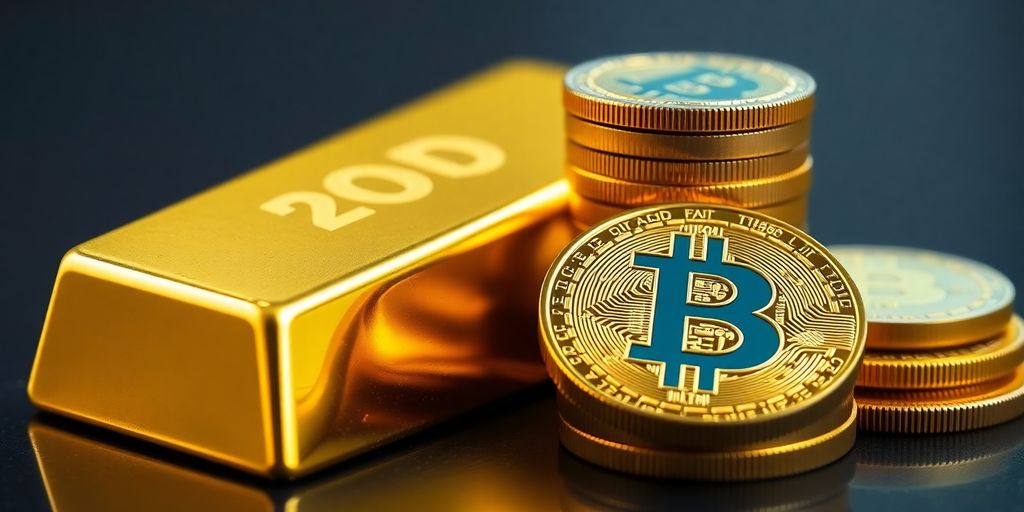Hey there! So, Bitcoin and gold, two big names in the world of assets, are making waves again. The Bitcoin-to-gold ratio just hit a new all-time high, which is a big deal for investors and market watchers. Bitcoin, often called the digital gold, is reaching new heights, and it’s got everyone talking. This article will break down why this matters and what it could mean for the future of these two heavyweights. Let’s dive into the details.
Key Takeaways
- Bitcoin’s price surge has pushed the BTC-to-gold ratio to a new all-time high.
- Both Bitcoin and gold are seen as safe havens, but each has unique advantages.
- Market dynamics in 2024 are influenced by institutional interest and global events.
- The political landscape is increasingly supportive of Bitcoin, impacting its growth.
- Investors are balancing Bitcoin and gold for diversification and risk management.
Bitcoin and Gold: A Historical Perspective

The Evolution of Bitcoin
Bitcoin started as a niche interest among tech enthusiasts but has grown into a significant financial asset. Its journey from a white paper in 2008 to surpassing $100,000 per coin by 2024 is nothing short of remarkable. Initially, Bitcoin was dismissed by many as "magic internet money," but its fixed supply of 21 million coins and increasing adoption have changed perceptions. This digital currency is now seen as a serious contender in the financial world, drawing attention from central banks and governments alike.
Gold’s Timeless Value
Gold has been a trusted store of value for over 5,000 years. It’s not just a shiny metal; it’s deeply ingrained in global commerce and cultural traditions. Gold is used in jewelry, electronics, and as a hedge against inflation. Despite the rise of digital currencies, gold’s liquidity and historical significance keep it relevant. Every day, over $160 billion in gold is traded, underscoring its importance in the global market.
Comparative Analysis of Scarcity
Both Bitcoin and gold are valued for their scarcity. Gold’s rarity comes from its finite supply on Earth, while Bitcoin’s scarcity is programmed, with a cap of 21 million coins. This scarcity is a key factor driving their value. However, unlike gold, Bitcoin is easily transportable and divisible, making it more versatile in some ways. As the bitcoin-to-gold ratio reaches new heights, surpassing 38, it highlights Bitcoin’s growing prominence in comparison to gold. This ratio indicates how many ounces of gold it takes to purchase one Bitcoin, showcasing the shifting dynamics between these two assets.
Market Dynamics: Bitcoin and Gold in 2024

Current Market Trends
As we step into 2024, Bitcoin continues to attract significant attention, having surpassed the $100,000 mark. This milestone isn’t just a number; it represents a shift in perception from a speculative asset to a recognized store of value. The comparison to gold is becoming more pronounced, with Bitcoin being dubbed ‘digital gold’ by many, including Federal Reserve Chairman Jerome Powell. Meanwhile, gold maintains its stronghold as a traditional safe haven, with central banks increasing their gold reserves, reflecting ongoing trust in its stability.
Institutional Adoption
Institutional interest in Bitcoin is on the rise. Major corporations and financial institutions are now viewing Bitcoin as a viable asset class. MicroStrategy’s aggressive Bitcoin acquisition strategy is a prime example, treating it as a treasury reserve asset. On the other hand, gold remains a staple in institutional portfolios, valued for its historical reliability and physical presence. The dual interest in both assets underscores their complementary roles in modern investment strategies.
Impact of Global Events
Global political and economic events continue to shape the dynamics between Bitcoin and gold. The political landscape, particularly in the U.S., is leaning towards a more crypto-friendly stance, with proposals like the BITCOIN Act signaling potential strategic reserves. In contrast, gold faces challenges from economic uncertainties and currency fluctuations. However, its role as a hedge against inflation remains unchallenged. The interplay of these factors will likely dictate the flow of capital between these two assets in the coming year.
As we navigate through 2024, the evolving dynamics between Bitcoin and gold will be pivotal in shaping investment strategies. Their interplay offers a unique perspective on how digital and traditional assets can coexist in a rapidly changing financial landscape.
The Bitcoin-to-Gold Ratio: Understanding Its Significance
What the Ratio Indicates
The Bitcoin-to-Gold ratio tells us how many ounces of gold one Bitcoin can buy. It’s a simple yet powerful metric that gives insight into the relative value of these two assets. When the ratio is high, Bitcoin is strong compared to gold. Recently, this ratio hit an all-time high of 40 ounces per Bitcoin, marking a significant shift in the financial landscape. This kind of movement suggests a growing confidence in Bitcoin’s role as a store of value, potentially rivaling gold’s long-standing position.
Historical Trends
Looking back, the Bitcoin-to-Gold ratio has had its ups and downs, much like the assets themselves. In the early days of Bitcoin, it was a volatile journey. Gold, on the other hand, has been a steady player for centuries. But as Bitcoin gained traction, especially in recent years, we’ve seen the ratio climb. This rise reflects not just Bitcoin’s price increase but also its acceptance into mainstream finance. It’s fascinating to see how Bitcoin, once considered "magic internet money," is now a formidable competitor to gold.
Future Projections
Predicting the future is always tricky, but we can make some educated guesses. If Bitcoin continues its upward trajectory, driven by factors like institutional adoption and geopolitical shifts, the Bitcoin-to-Gold ratio might keep climbing. Some analysts even suggest it could surpass 50 ounces per Bitcoin if current trends persist. However, it’s essential to remember that both assets are subject to market forces, and shifts in global economics or policy could impact this ratio significantly.
As we watch these developments, it’s clear that the financial world is evolving. Bitcoin’s rise against gold isn’t just about numbers; it’s about changing perceptions and the potential for a new era in asset valuation.
In conclusion, the Bitcoin-to-Gold ratio is more than just a number. It symbolizes the dynamic interplay between traditional and digital assets, each vying for a place in the portfolios of tomorrow’s investors. As we move forward, keeping an eye on this ratio will be crucial for understanding the broader economic shifts at play.
Political Influences on Bitcoin and Gold
Regulatory Changes
In recent years, the political landscape has significantly influenced both Bitcoin and gold markets. Regulatory changes have played a crucial role. With the new administration in the U.S., there’s a shift towards crypto-friendly policies. The nomination of crypto advocates to key positions, like the head of the U.S. Securities and Exchange Commission, signals a potential easing of regulations. This could encourage more institutional investments in Bitcoin. On the other hand, gold regulations remain more stable, reflecting its established status in the financial system.
Government Reserves
Governments worldwide are reconsidering their reserves. Traditionally, gold has been the cornerstone of national reserves. However, there’s a growing interest in Bitcoin as a strategic asset. For instance, the proposal of a U.S. strategic Bitcoin reserve, similar to the Strategic Petroleum Reserve, highlights this shift. Such a reserve could act as a buffer against economic instability. Meanwhile, gold continues to be a reliable asset, with central banks purchasing significant amounts to strengthen their reserves.
Political Endorsements
Political endorsements have also impacted these markets. Notably, the crypto industry’s influence in elections has raised eyebrows. In Ohio, for example, significant crypto funding helped secure a Senate seat, underscoring the sector’s growing political clout. This influence could shape future policies favoring digital currencies. Conversely, gold’s political endorsements are more subdued, often tied to its historical value and stability as a financial asset.
As we navigate these political shifts, the interplay between Bitcoin and gold continues to evolve, influenced by regulatory changes, government strategies, and political endorsements. This dynamic landscape offers both challenges and opportunities for investors.
Investment Strategies: Balancing Bitcoin and Gold
Diversification Benefits
Balancing investments in gold and Bitcoin can be a smart move for those looking to diversify their portfolios. Gold has always been a reliable asset, a safe haven during uncertain times. Its value doesn’t fluctuate wildly, making it a stabilizing force. Bitcoin, on the other hand, offers growth potential due to its digital nature and increasing acceptance. By allocating resources to both, we can enjoy the stability of gold while also tapping into the potential high returns of Bitcoin.
Risk Management
Managing risk is crucial when investing in both gold and Bitcoin. Bitcoin’s volatility can be daunting, with prices swinging dramatically in short periods. This is where gold’s stability comes into play, acting as a buffer against Bitcoin’s unpredictability. We should consider strategies like dollar-cost averaging, which involves investing a fixed amount regularly regardless of price. This method can help mitigate the impact of market volatility.
Long-Term vs Short-Term Holding
When deciding between long-term and short-term holding, it’s essential to understand our investment goals. Gold, with its historical track record, is often seen as a long-term hold, providing steady returns over time. Bitcoin, while more volatile, can offer substantial short-term gains if timed correctly. However, holding Bitcoin long-term could also prove beneficial as it gains wider adoption and potentially appreciates in value. Balancing both strategies allows us to capitalize on Bitcoin’s growth while relying on gold’s enduring value.
In the ever-changing financial landscape, balancing Bitcoin and gold investments is not just about choosing one over the other. It’s about understanding their unique benefits and risks and using them to create a resilient investment strategy.
Technological Advancements: Bitcoin’s Edge Over Gold
Blockchain Technology
In the world of finance, blockchain technology stands out as a revolutionary force. Unlike gold, which relies on physical transactions and storage, Bitcoin operates on a decentralized ledger system. This blockchain enables secure, transparent, and immutable transactions, making it a preferred choice for many investors. The technology behind Bitcoin ensures that every transaction is verified by multiple sources, reducing the risk of fraud and increasing trust among users.
Digital Transactions
When we talk about ease of transactions, Bitcoin clearly has the upper hand. Traditional gold transactions can be cumbersome, involving physical transfer and often requiring third-party verification. In contrast, Bitcoin allows for quick, peer-to-peer digital transactions without the need for intermediaries. This not only speeds up the process but also reduces costs significantly. For those who value efficiency and cost-effectiveness, Bitcoin presents a compelling case over gold.
Security Features
Security is a major concern in any financial transaction. While gold has been a secure store of value for centuries, Bitcoin introduces advanced security features that are hard to beat. With cryptographic security measures, Bitcoin ensures that assets are protected against unauthorized access. The decentralized nature of Bitcoin further enhances its security, as there is no central point of failure. This makes Bitcoin not just a digital currency, but a secure investment vehicle.
As we navigate through the complexities of modern finance, it’s clear that Bitcoin’s technological edge offers superior liquidity and long-term growth potential compared to traditional assets like gold. The future of finance is digital, and Bitcoin is leading the charge.
Cultural Perceptions: Bitcoin and Gold in Society

Public Sentiment
As we look around, it’s clear that both Bitcoin and gold have carved out unique places in our collective mindset. Bitcoin, once dismissed as "magic internet money," is now recognized as a legitimate financial asset. This shift is largely due to its growing acceptance by governments and financial institutions. For instance, El Salvador’s adoption of Bitcoin as legal tender has sparked debates worldwide about the future of digital currencies. Meanwhile, gold continues to be revered for its historical significance and tangible value, standing as a trusted store of wealth across cultures.
Media Representation
The media plays a crucial role in shaping how we perceive Bitcoin and gold. Bitcoin often grabs headlines with its volatile price swings, drawing both intrigue and skepticism. Media narratives around Bitcoin tend to oscillate between portraying it as a revolutionary financial tool and a risky, speculative asset. On the other hand, gold is frequently depicted as a stable, albeit less exciting, investment. Its portrayal is often linked to its enduring status as a safe haven during economic uncertainty.
Cultural Significance
Culturally, gold has been embedded in our traditions for millennia, symbolizing wealth and prosperity in ceremonies and rituals. Its use in jewelry and art underscores its aesthetic and economic value. Bitcoin, while newer, is beginning to forge its own cultural path. It’s viewed by some as a symbol of technological advancement and financial independence. As we continue to evolve, the historical evolution of money, including both Bitcoin and gold, reflects broader societal shifts toward digital and decentralized systems.
The narratives we attach to Bitcoin and gold reveal much about our values and aspirations, highlighting our desire for security, innovation, and progress. As these assets continue to evolve, so too will their roles in our societies.
The Role of Central Banks in Bitcoin and Gold Markets
Central Bank Policies
Central banks play a pivotal role in shaping the financial landscape. Their policies can significantly impact both traditional and digital assets. In the past, central banks have primarily focused on gold as a reserve asset due to its historical stability and intrinsic value. However, with the rise of digital currencies, there’s a growing debate about whether Bitcoin could serve a similar role. Bitcoin’s potential as a reserve asset is gaining traction, thanks to its fixed supply and increasing acceptance.
Gold Reserves
Gold has long been a cornerstone of central bank reserves. Its enduring value and liquidity make it a preferred choice for many financial institutions. In fact, recent data shows that central banks have been increasing their gold purchases, reflecting ongoing confidence in the metal’s role as a safe haven. Gold reserves act as a buffer against economic uncertainties, providing a stable foundation for national economies.
Bitcoin as a Strategic Asset
There’s a burgeoning interest in Bitcoin as a strategic asset for central banks. Unlike gold, Bitcoin offers the advantage of digital liquidity, allowing for seamless transactions on a global scale. Some countries are exploring the idea of incorporating Bitcoin into their reserves, recognizing its potential to diversify and strengthen their financial portfolios. Dr. Ferranti highlights Bitcoin’s liquidity, which can handle large transactions, similar to gold, raising questions about its future role in global finance.
As we move forward, the interplay between central banks and these assets will likely evolve, influenced by technological advancements and changing economic conditions. Balancing traditional practices with innovative approaches could redefine how central banks manage their reserves in the future.
Future Outlook: Bitcoin and Gold in a Changing Economy

Predictions for Bitcoin
In the ever-evolving world of finance, Bitcoin is making waves. It’s not just a digital curiosity anymore; it’s a serious player in the global economy. With Bitcoin recently surpassing the $100,000 mark, analysts are buzzing with predictions. Some experts, like those from Bernstein, suggest that Bitcoin could potentially replace gold in the economy over the next decade, although this transition will be gradual. The idea of Bitcoin reaching $200,000 by late 2025 is no longer far-fetched, especially with institutional investors showing increased interest. Large firms and even governments are recognizing Bitcoin’s potential as a strategic asset, and this shift in perception is setting the stage for significant growth.
Gold’s Resilience
While Bitcoin is gaining attention, gold’s role as a stable and timeless asset remains unchallenged. Gold has been a cornerstone of wealth preservation for thousands of years. Despite the digital revolution, gold’s physical properties make it irreplaceable in certain industries, such as jewelry and electronics. The demand for gold remains strong, with central banks continuing to bolster their reserves. Even in a world where digital currencies are gaining traction, gold’s resilience is evident as it continues to trade robustly, with daily volumes second only to the S&P 500.
Potential Market Shifts
Looking ahead, we anticipate several shifts in the market dynamics between Bitcoin and gold. As Bitcoin becomes more mainstream, it could attract a larger share of investment portfolios traditionally dominated by gold. However, this doesn’t necessarily spell trouble for gold. Instead, it highlights a broader diversification strategy for investors. We might see more mixed portfolios that balance the volatility of Bitcoin with the stability of gold. In the coming years, both assets could coexist, each playing to their strengths in a diversified investment strategy.
As we navigate this changing landscape, it’s crucial to consider how these two assets can complement each other in a portfolio. Balancing the old with the new could be the key to navigating future economic shifts.
Conclusion
In wrapping up, it’s clear that Bitcoin’s recent surge past $100,000 has not only caught the attention of investors but also sparked a broader conversation about its role alongside traditional assets like gold. Both Bitcoin and gold have their unique strengths—Bitcoin with its digital scarcity and gold with its historical significance and practical uses. As Bitcoin continues to gain traction, it’s carving out its own niche as a modern store of value. However, it’s important to remember that while Bitcoin’s potential is exciting, its volatility remains a factor to consider. Balancing investments between these two assets could offer a diversified approach, allowing investors to benefit from the stability of gold and the growth potential of Bitcoin. As the financial landscape evolves, keeping an eye on both could be a wise move.
Frequently Asked Questions
What is the Bitcoin-to-Gold ratio?
The Bitcoin-to-Gold ratio shows how many ounces of gold you need to buy one Bitcoin. It’s a way to compare the value of Bitcoin to gold.
Why is Bitcoin compared to gold?
Bitcoin is often compared to gold because both are seen as stores of value. They are limited in supply, with Bitcoin capped at 21 million coins, similar to gold’s natural scarcity.
How has Bitcoin’s price reached over $100,000?
Bitcoin’s price has surged past $100,000 due to increased global adoption, interest from large institutions, and its fixed supply, which makes it scarce and valuable.
What role do central banks play in the gold market?
Central banks buy and hold gold as part of their reserves to stabilize their currency and economy. They see gold as a safe asset during uncertain times.
Can Bitcoin replace gold as a store of value?
Some believe Bitcoin could replace gold as a store of value because it is digital and scarce. However, gold has been trusted for thousands of years, and Bitcoin is still relatively new.
How do global events affect Bitcoin and gold prices?
Global events like economic crises or political changes can drive people to invest in safe assets like gold and Bitcoin, affecting their prices.
What are the risks of investing in Bitcoin?
Investing in Bitcoin comes with risks like high price volatility and regulatory changes. It’s important to understand these risks before investing.
How can I balance investing in Bitcoin and gold?
Balancing investments in Bitcoin and gold involves diversifying your portfolio to manage risk, considering both short-term and long-term goals.





